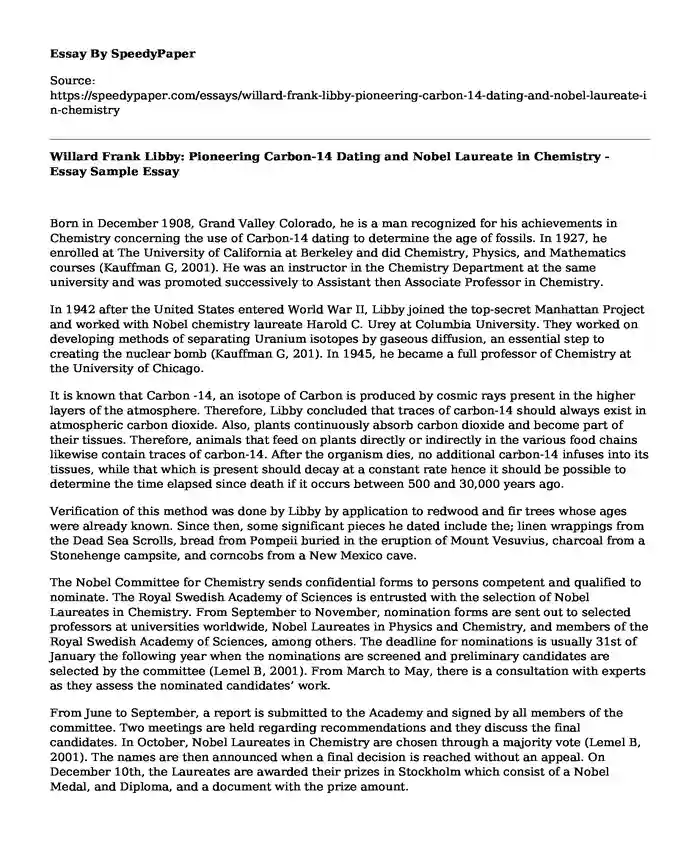Born in December 1908, Grand Valley Colorado, he is a man recognized for his achievements in Chemistry concerning the use of Carbon-14 dating to determine the age of fossils. In 1927, he enrolled at The University of California at Berkeley and did Chemistry, Physics, and Mathematics courses (Kauffman G, 2001). He was an instructor in the Chemistry Department at the same university and was promoted successively to Assistant then Associate Professor in Chemistry.
In 1942 after the United States entered World War II, Libby joined the top-secret Manhattan Project and worked with Nobel chemistry laureate Harold C. Urey at Columbia University. They worked on developing methods of separating Uranium isotopes by gaseous diffusion, an essential step to creating the nuclear bomb (Kauffman G, 201). In 1945, he became a full professor of Chemistry at the University of Chicago.
It is known that Carbon -14, an isotope of Carbon is produced by cosmic rays present in the higher layers of the atmosphere. Therefore, Libby concluded that traces of carbon-14 should always exist in atmospheric carbon dioxide. Also, plants continuously absorb carbon dioxide and become part of their tissues. Therefore, animals that feed on plants directly or indirectly in the various food chains likewise contain traces of carbon-14. After the organism dies, no additional carbon-14 infuses into its tissues, while that which is present should decay at a constant rate hence it should be possible to determine the time elapsed since death if it occurs between 500 and 30,000 years ago.
Verification of this method was done by Libby by application to redwood and fir trees whose ages were already known. Since then, some significant pieces he dated include the; linen wrappings from the Dead Sea Scrolls, bread from Pompeii buried in the eruption of Mount Vesuvius, charcoal from a Stonehenge campsite, and corncobs from a New Mexico cave.
The Nobel Committee for Chemistry sends confidential forms to persons competent and qualified to nominate. The Royal Swedish Academy of Sciences is entrusted with the selection of Nobel Laureates in Chemistry. From September to November, nomination forms are sent out to selected professors at universities worldwide, Nobel Laureates in Physics and Chemistry, and members of the Royal Swedish Academy of Sciences, among others. The deadline for nominations is usually 31st of January the following year when the nominations are screened and preliminary candidates are selected by the committee (Lemel B, 2001). From March to May, there is a consultation with experts as they assess the nominated candidates’ work.
From June to September, a report is submitted to the Academy and signed by all members of the committee. Two meetings are held regarding recommendations and they discuss the final candidates. In October, Nobel Laureates in Chemistry are chosen through a majority vote (Lemel B, 2001). The names are then announced when a final decision is reached without an appeal. On December 10th, the Laureates are awarded their prizes in Stockholm which consist of a Nobel Medal, and Diploma, and a document with the prize amount.
Libby was a Physical Chemist and a specialist in radiochemistry, particularly hot atom chemistry, tracer techniques, and isotope tracer work. He was awarded the Nobel Prize in 1960. Moreover, he has received other distinctions including the Research Corporation Award for 195, the Chandler Medal of Columbia University, and the Elliot Cresson Medal for the Franklin Institute among others. He made significant discoveries and his work displayed how Chemistry and other subjects especially History and Geology are related.
References
Lemmel, B. (2001). Nomination and selection of the Nobel laureates. In The Nobel Prize: The First 100 Years (pp. 25-28) https://www.nobelprize.org/nomination/chemistry/
Kauffman, G. (2020, January,1). Willard Frank Libby. Berkeley College of Chemistry. https://chemistry.berkeley.edu/news/willard-frank-libby
Cite this page
Willard Frank Libby: Pioneering Carbon-14 Dating and Nobel Laureate in Chemistry - Essay Sample. (2023, Dec 23). Retrieved from https://speedypaper.net/essays/willard-frank-libby-pioneering-carbon-14-dating-and-nobel-laureate-in-chemistry
Request Removal
If you are the original author of this essay and no longer wish to have it published on the SpeedyPaper website, please click below to request its removal:
- Essay Sample: Production Logging Tools in Reservoir Monitoring
- Free Essay: What Is to Be Scientific?
- Mass Cropping: A Solution to Global Food Security & Threat to Ecosystem - Essay Sample
- Paper Example: Probability of Obtaining Heads on a Coin Toss
- Annotated Bibliography on Corporate Philanthropy: A Tool for Political Influence?
- Social Media and Democracy: Navigating Political Beliefs and Participation in the Digital Age - Essay Sample
- Internet of Things (IoT): Data in Business - Essay Sample
Popular categories





